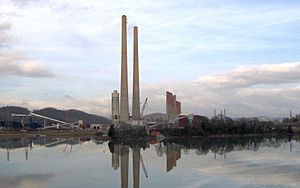Kingston Fossil Plant facts for kids
Quick facts for kids Kingston Fossil Plant |
|
|---|---|

Kingston Fossil Plant
|
|
| Country | United States |
| Location | Roane County, Tennessee, near Kingston, Tennessee |
| Coordinates | 35°53′54″N 84°31′08″W / 35.89833°N 84.51889°W |
| Status | Operational |
| Commission date | Unit 1: February 8, 1954 Unit 2: April 29, 1954 |
| Owner(s) | Tennessee Valley Authority |
| Operator(s) | Tennessee Valley Authority |
The Kingston Fossil Plant, also known as the Kingston Steam Plant, is a large power plant in Roane County, Tennessee. It sits on the shore of Watts Bar Lake near Kingston, Tennessee. This plant uses coal to make electricity. It is run by the Tennessee Valley Authority, often called TVA. The plant became well-known because of a large coal ash spill that happened there in 2008.
Contents
A Look Back: Building the Kingston Plant
Construction of the Kingston Fossil Plant started on April 30, 1951. When it was finished in 1955, it was the biggest coal-fired power plant in the world! Its main job was to provide electricity for the nearby Oak Ridge National Laboratory. A special ceremony to celebrate the plant's opening happened on November 17, 1955.
How the Plant Makes Power
The plant has nine big machines that make electricity. These are called generating units. Four units started working in 1954. Each of these could make 175 MW of power. Five more units started in 1955. Each of these could make 200 MW. Together, the plant can produce about 1,398 MW of electricity. It uses about five million tons of coal each year. This coal helps make about ten billion kilowatt hours of electricity.
Cleaning the Air
All nine generating units have special systems called selective catalytic reduction (SCR). These systems help reduce harmful gases called nitrogen oxide (NO
x ). These gases can cause ozone pollution in the air.
Changes to the Chimneys
Originally, the plant had nine chimneys. In 1976, these were replaced by two very tall chimneys, each about 1,000 feet (304.8 meters) high. Later, in 2007, these two tall chimneys were replaced by a single chimney. This new chimney is connected to special equipment called "scrubbers" that help clean the air even more.
A Spot for Birdwatchers
The plant is also a popular place for birdwatchers. Many different kinds of waterfowl, like ducks and geese, come to the settling and treatment ponds near the plant.
The 2008 Coal Ash Spill
In December 2008, a storage area at the plant broke. This released a very large amount of coal fly ash slurry. Fly ash is a powdery material left over after coal is burned. This spill covered about 300 acres (1.2 square kilometers) of land. It also flowed into nearby rivers like the Emory River and Clinch River. These rivers are connected to the Tennessee River. This event was the largest accidental release of coal fly ash in the United States.
Working with the EPA to Protect the Air
On April 14, 2011, the U.S. Environmental Protection Agency (EPA) made an agreement with the Tennessee Valley Authority (TVA). This agreement was about following clean air rules at 11 of TVA's coal plants. As part of this agreement, the Kingston Fossil Plant's nine units must always use their SCR systems. This helps to keep reducing the NO
x gases that go into the air.

